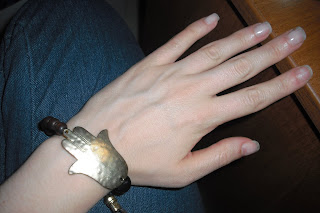Sunday, December 16, 2012
Hamsa
I have several pieces of jewelry that display "hamsas" or the "Hand of God," as I grew up understanding it to be. It wasn't until I interned at Beit Hatfutsoth, or the Museum of Jewish Peoplehood in Israel, that I learned about the textured history of this symbol. In Islam, the "hamsa" was referred to as the "Hand of Fatimah," the daughter of Muhammad, but no doubt due to the interplay of culture seen in many Middle eastern lands, the hand also became known as "Miriam's Hand." I considered this a natural progression of symbols, but after taking this course, I view the change as a reappropriation of signs. Even if Jewish thought did not invent the "hamsa" and are borrowing the symbol, Jews have done something to it that is historically Jewish. While considering the eruv within the context of reconstituting Jewish ritual, in her work Space and Place in Jewish Studies, Barbara Mann refers to the eruv as "a durable and age old form of recylcing [which] is also one definition of tradition: the preservation and conservation of old customs within new settings" (Mann 143). As a student of Jewish Art History, I have found that the recycling and reuse of ritual objects is something that punctuates Jewish art and custom. "Hamsas" now adorm our necks, hang on our walls, and even keychains (like my own). They have become pervasive in our culture, visible by the many artistic interpretation of their form. This can be seen even in my small collection of various "hamsas". The "hamsa" now worn by Jews has come a long way from "Fatima's Hand" with regards to material, form, structure, and embellishment, often times created by Jews for Jews with a Jewish purpose and intent. Now, by marking ourselves with a "hamsa" we are subscribing to our Judaism.
To be quite honest, the symbol has an aura of exoticness for me, I believe I can trace a parallel culture in the wide phalanges, exciting and otherworldly compared to my own Ashkenazi heritage. Even if this symbol does have Islamic origins, I can only recount seeing Jews wearing this symbol. It has become a Jewish signifier, all the more popular with Jews of varying cultural backgrounds populating the land of Israel.
My necklace with the blue beads is by a Israeli designer named Adaya Bar, the bracelet is something I picked up at a flea festival in Chicago, and the floral "hamsa" is another design of Michal Negrin.
Subscribe to:
Post Comments (Atom)


No comments:
Post a Comment